Let’s be honest: marketing your dental practice can feel like a yawn. Your patients are nervous to come into your office, and some of them even shiver at the thought of a routine cleaning. You assume the last thing they want to see is more of you and the dentist’s chair popping up on their social media.
We all need to accept that dental marketing isn’t, say, fashion or gourmet food marketing. It’s decidedly less interesting on the surface. Which, we argue, is exactly why your practice should be using social media.
First of all, your patients and potential patients are already there. Older patients are on Facebook, while younger patients are on Instagram.
Secondly, social media lets you differentiate your practice from all the rest. Everyone has to go the dentist, period. To go or not to go isn’t the choice – which dentist to pick is the real decision. How will potential clients choose you?
In this article, we’ll show examples from real dentists who put extra thought into their social media posts, share the types of posts that attract new followers, and tell you three pitfalls to avoid.
11 Social Media Ideas + Examples from Real Dentists
The main battle when creating Facebook and Instagram posts for your dental practice is straddling the line between posting information that’s actually compelling and making sure to reiterate that you are a dentist who wants customers. Since dental marketing can easily veer into boring territory, it’s important to strike the right balance.
1. Add social proof.
People trust dentists that other patients trust. Add social proof to your profile, either by including it in your bio, like @dentistryofsf does on Instagram or by posting rave reviews.
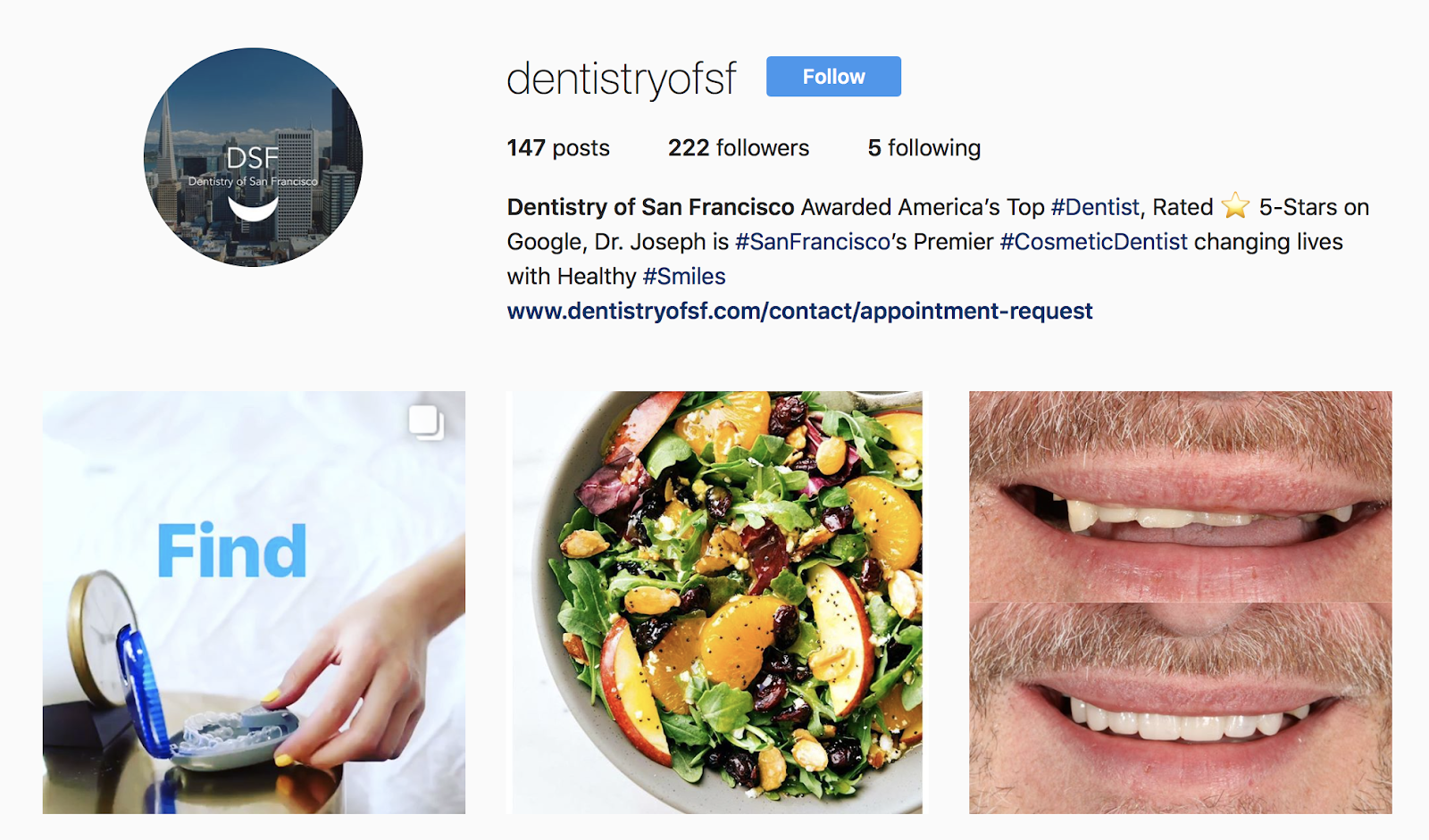
2. Clarify the detail that makes you stand out.
What does your practice do that others don’t? Think of the thing that differentiates you, and then make sure your audience knows about it. For example, maybe you offer financing options, which is great news for freelancers who don’t have health insurance (and an excellent offer if your practice is in an area with a strong gig economy). Since you don’t want every single post to be promotional, this is the type of info to include in your bio.
3. Cross-promote with other brands.
When you team up with other brands or professionals, you immediately expand your reach while appealing to your core audience’s needs and wants. A great example of this is @cpwdentistry, which offers a swag bag from @Boka (a company that sells oral care products) to new clients who book an appointment.
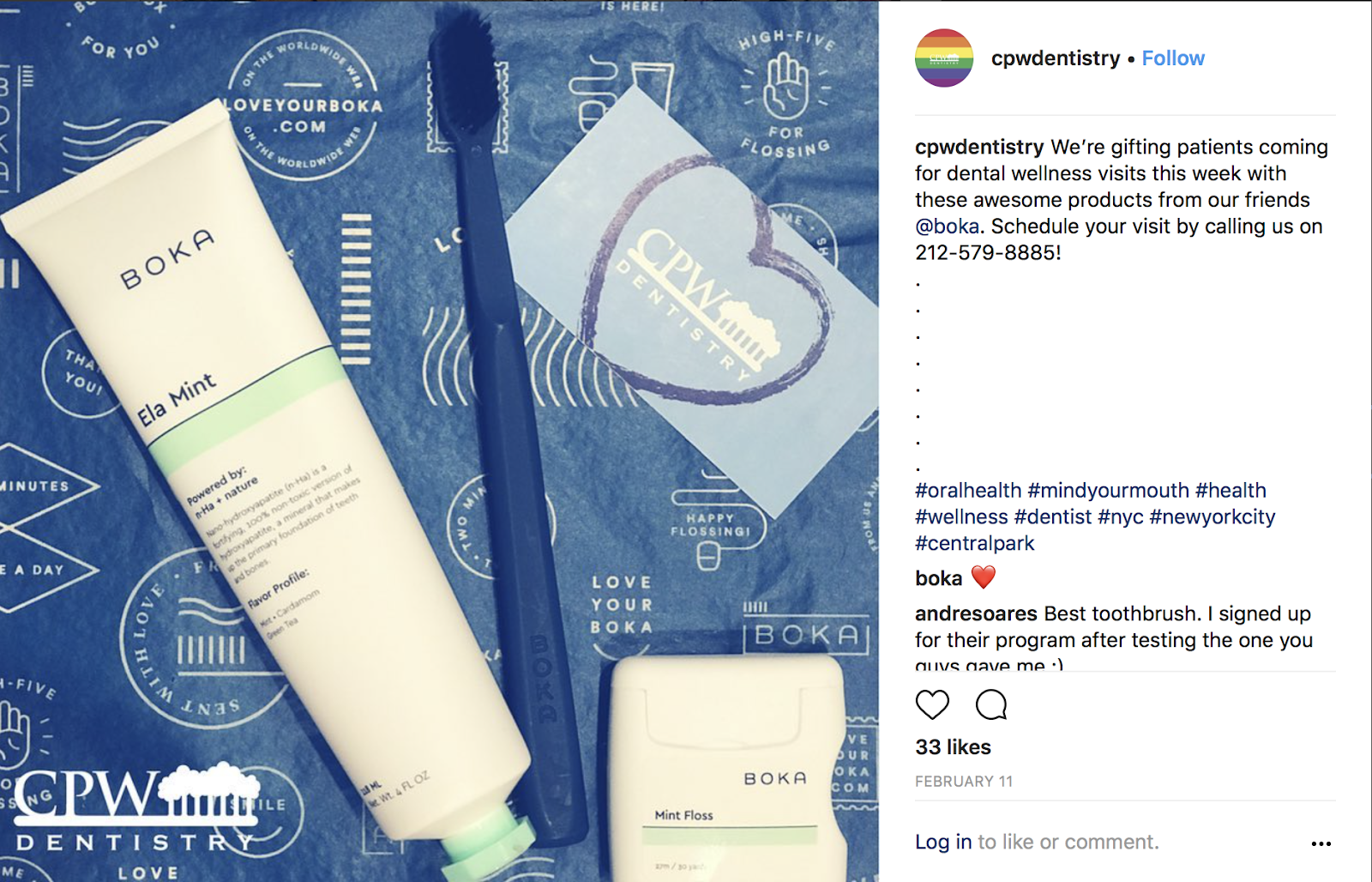
Another option is to cross-promote with a nearby local business that appeals to the same audience, like a health food store or wellness center. This is also a good way to encourage people to follow your account in the first place – if they see that a brand or influencer they like is promoting you, they could be convinced to follow you.
4. Discuss crossover interests.
Think about it: most folks aren’t on social media to hear from their dentist. So think about what else they might be interested in that’s kinda-sorta related.
For example, Colorado is one of the healthiest states in the country, so it stands to reason that potential dental clients are also going to be interested in leading a healthy lifestyle. You can create a profile like @thefoodie_dentist did, with posts about healthy eating and nutritional recipes. By appealing to a topic that’s more interesting than dental care, you can build your follower list, increasing the people who will eventually see your promotional posts.
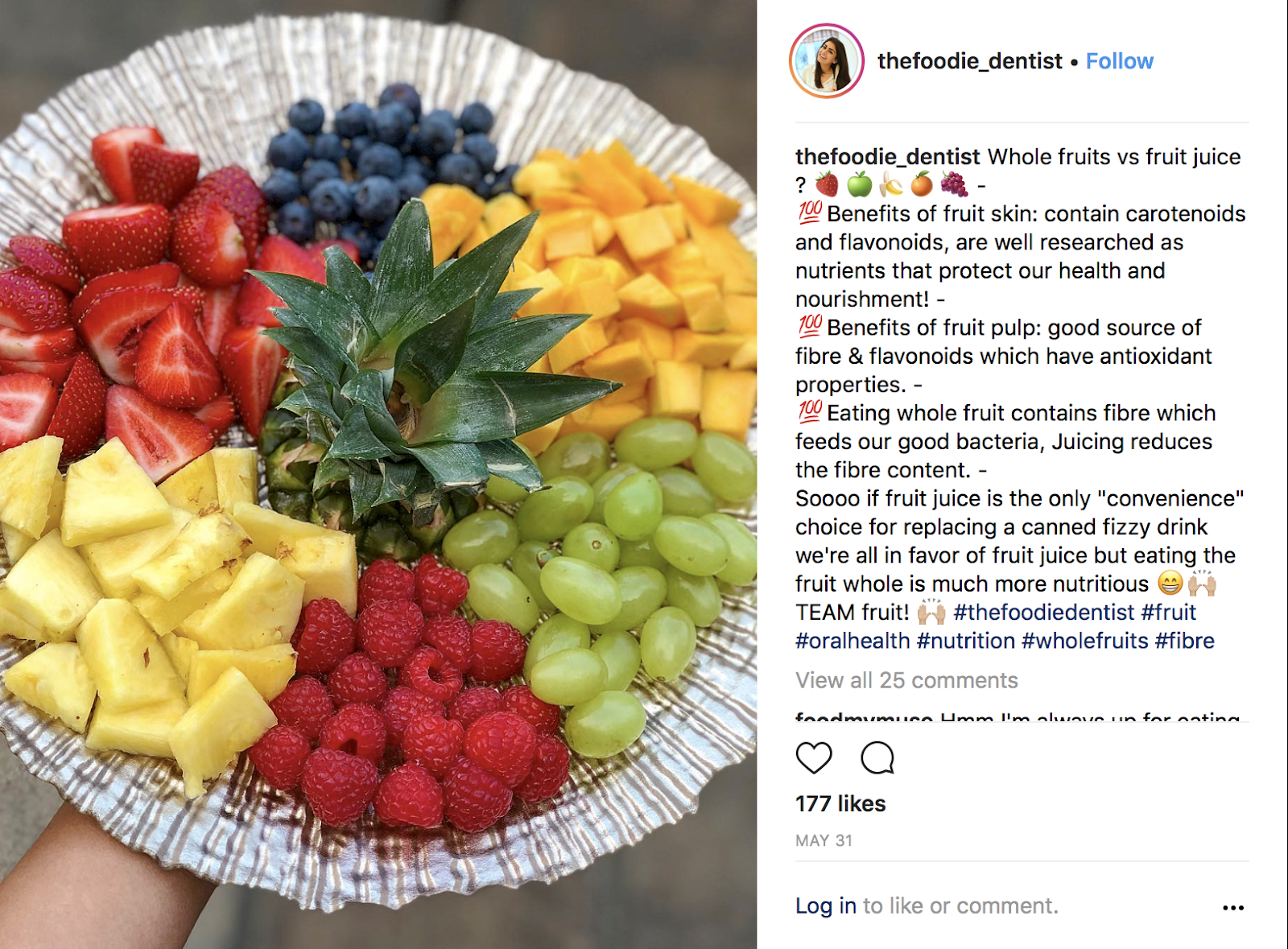
5. Get involved with the community.
No matter how many people you appeal to on social media, you won’t snag any new clients if you don’t have a local focus.
Use your social media to showcase how you stay involved with the community like @valley_pediatric_dentistry does (even their bio talks about it). By creating a community-centered social media account, you may get local followers who trust you to share information about their town or neighborhood – you can become a sort of mini news source for locals.

6. Go heavy on branding.
If you want your social media posts to stand out, put some thought into how they’re branded. If you choose a similar aesthetic or color scheme for all of your photos, or if you always use the same font and wording, your posts will be more recognizable.
By using colorful illustrations on their Instagram account, @dentistirvine has a collection of highly branded content that immediately tells the viewer who’s posting.
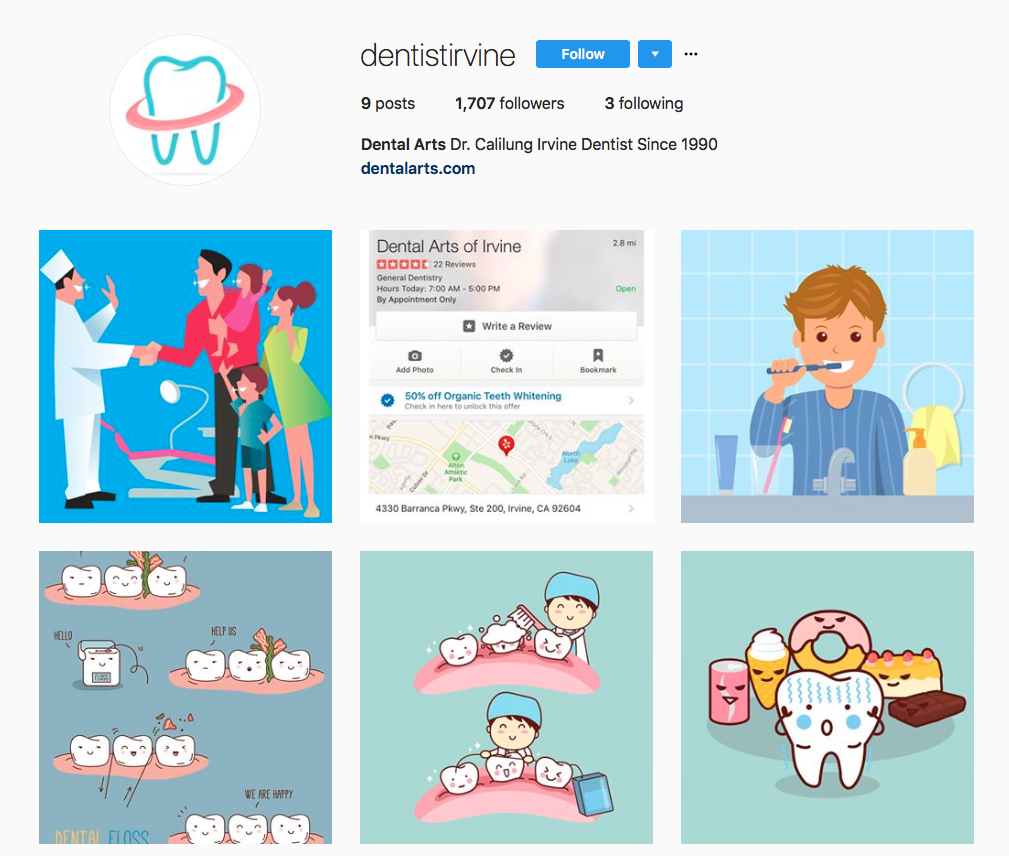
7. Have a shtick.
Create a signature that distinguishes you. You don’t have to go as far as @dentistsinging, a singing dentist, but find something that makes you stand out from your competition. People may not be motivated to follow a dentist who posts about teeth care, but they may want to see a dentist who’s willing to embarrass himself a bit for your entertainment.
8. Run targeted Facebook Ads.
Since dental marketing should focus on local audiences, it’s a good idea to try out Facebook ads, which offer a ton of targeting options. For example, a pediatric dentist can create an ad to target local moms. The ad can include a video that talks about the importance of dental hygiene for children. Then, the members of that first audience who showed interest in the ad can be retargeted with a more promotional ad that has a “book now” CTA, possibly with a discount offer.
Last I checked, they don’t teach Facebook Advertising in dental school. Fortunately. Jumper Media offers low-cost Facebook Ads packages perfect for dentists looking to get new customers quickly.

9. Showcase before and after photos.
Dental treatments don’t make for the most appealing before and after photos, but if you offer cosmetic treatments, showing the results, like @dentistcalgary does, may grab the attention of people who are considering them. People love before and after photos, especially if they’re of a treatment that a potential client is thinking about getting.
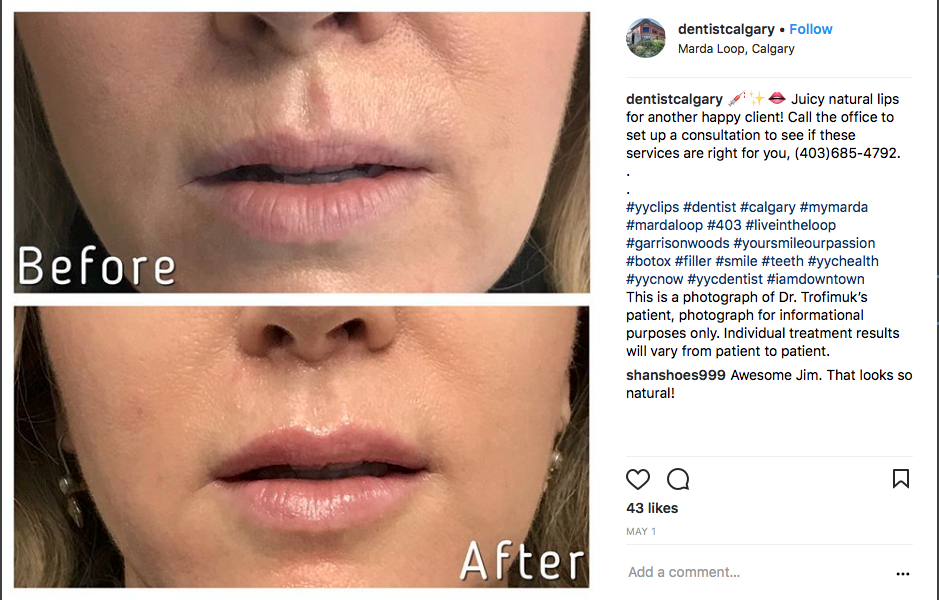
10. Sprinkle in promotions sparingly.
One of the cornerstone rules of marketing is that you don’t want to hit your audience over the head with promotions. Instead, add a promotion for every four or five value-focused posts. For example, @annarborsdentist run a lifestyle account with some dental care advice and few obvious promotions. The account handle always reminds you who it is – a dentist in Ann Arbor – but the posts make you want to talk to this person about shared interests.

11. Uncover compelling industry-focused information.
It may seem like we’re suggesting that almost every post you put up is about something other than dental health, but we’re not – we feel that there’s plenty of compelling content that’s closely related to your practice. Here are a few titles that people would be interested in, and that walk the line between straightforward promotion and more general information:
- 5 Tips to Get Whiter Teeth in One Month
- The Healthiest Oral Care Products to Use at Home
- How to Choose a Toothbrush for Sensitive Teeth
Think about the questions you get asked a lot, then create content to answer these questions. You can put the answer in a social media post itself, like in a video that you add as a Highlight to Instagram, or you can put up a link to your blog post on Facebook.

Always, Always, Always Provide Value
This can’t be stressed enough: no matter what you’re posting, you need to always provide value. This is true whether you’re putting together an advertisement or a funny video, whether you’re giving away a basket of free goodies or you’re showing before and after photos.
You should always be thinking about what your audience will get out of the post.
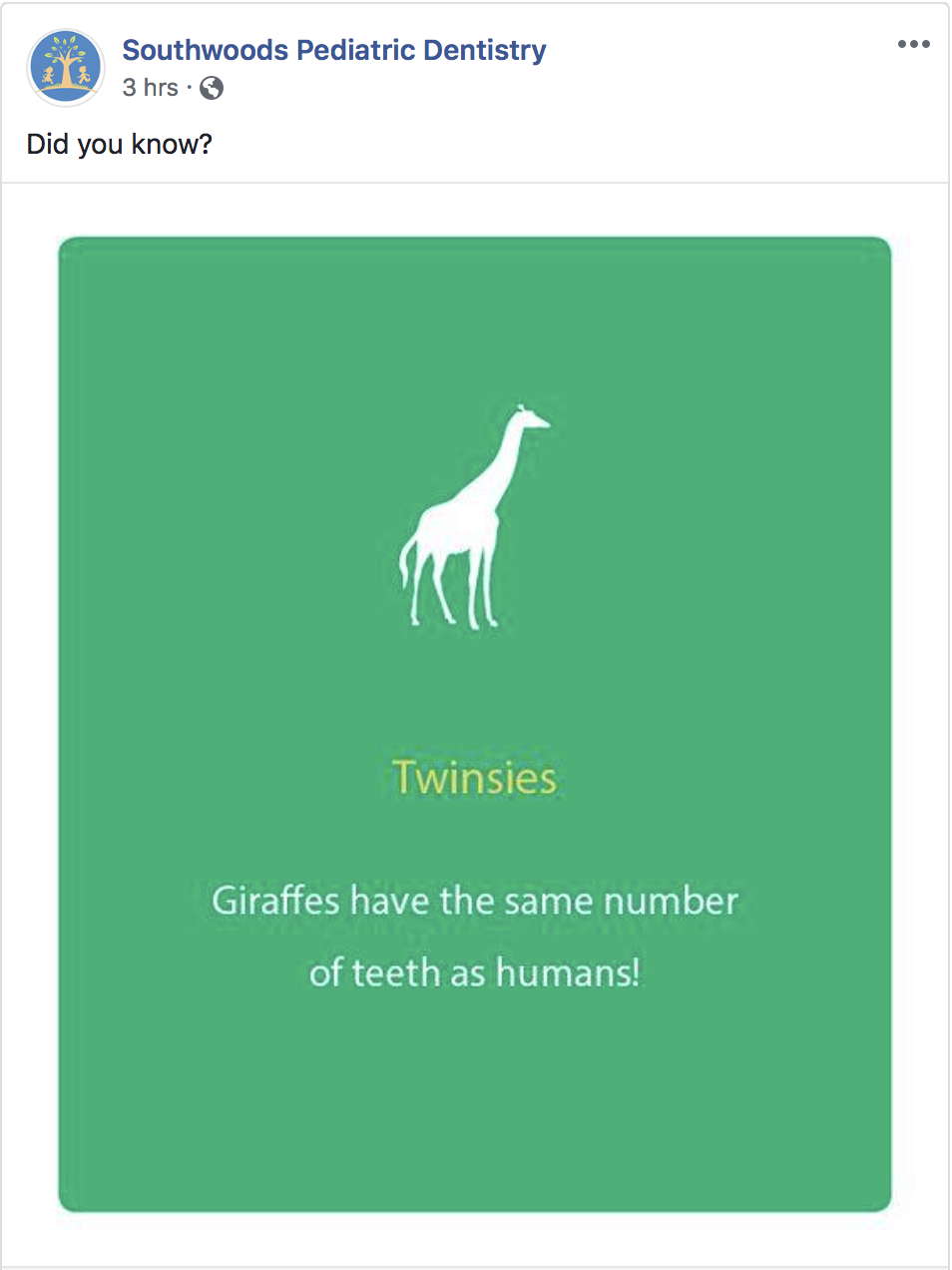
Here are a few examples:
- Choose a crossover interest that will entice your audience. A good crossover interest is leading a healthy lifestyle – you can post tips, tools, recipes, encouragement, etc. Also, people who care about keeping their teeth clean and their smile beautiful may also be interested in dermatology and skin care. Beauty, health and fitness, and fashion are some of the most popular niches on Instagram, and there’s potential for adding these topics into your feed.
- When it comes to social proof and before and after photos, think about the treatments or information your customers care about most. Don’t waste your time showing reviews or photos of treatments that nobody is concerned with like teeth cleaning.

- Pick partners for cross-promotions that have a different sort of appeal than your dental office does. For example, pairing up with a company that makes delicious, organic cookies is more interesting than pairing up with a doctor’s office. There’s a caveat to this, though. A lot of dentists are part of large medical groups, making it easy to partner up with several other medical professionals. If there’s a doctor in the group that has a large fan base on social media, it’s a great idea to find out if they’ll trade promotions with your practice.
3 Common Marketing Pitfalls to Avoid
To keep your audience interested, avoid these three types of posts:
1. Self-Focused Community Involvement
Let’s say your dental office is participating in a 5K. Your first thought may be to show photos of you and your team at the 5K wearing branded shirts that feature your practice’s name. You tag everyone in the photo to increase your reach. You think, “Great, we’re involved with the community, and now everybody knows it!” Except, that post is still all about you.
Instead, post a few weeks before the 5K, encouraging locals to get involved. Include information they’ll need and links to the signup or sponsorship form. On race day, take photos of other teams and tag their company in the photos you post. Afterward, show how you and the other runners are celebrating with a post-race beer at a nearby brewery (and tag the brewery in the post).
This way, not only are you promoting your practice, but you’re also showcasing other people and businesses in the area – you’re truly getting involved.
And P.S. – that post with all of your employees wearing their team shirts still has a place in your feed, but now it’ll be mixed in with other worthwhile posts.
2. Boring Industry Speak
There’s nothing better than loving your job, and if you’re riveted by the latest technological advances in the dental industry, that’s amazing. However, your audience doesn’t care about how you do what you do – they care about the results and how your practice can improve their life. For most patients, that means making dental appointments as painless and free of a threat as possible.
If you use industry speak, you’re not being transparent, you’re being confusing, even boring. Remember, you’re not trying to attract other professionals, you’re trying to attract the layman patient who just wants to get through their dental appointment with as little fear, pain and recovery time as possible.
Sometimes, though, patients do actually want to hear about the process behind what you’re doing, especially if it’s going to remove some of their anxiety. The key is to listen closely to what your patients need. If you feel that you’re being asked the same question over and over (“What is that scary machine? Why does laughing gas make me feel so loopy?”), clarifying it with some science or tech could help.
3. Photos of Your Team
We’re not sure why, but posting photos of employees seems to be a tactic that a lot of dental practices (and businesses in general) utilize. We just don’t think this is interesting. Yes, it may be comforting to know what your dentist looks like before you walk into their office for the first time, but there’s no need to show every employee who works at the front desk. If you do think that your team has the value to translate to social media, consider recording a video of them saying something interesting, like offering a tip or promoting a big discount.
Does your dental practice have an Instagram page?
Tell us what it is in the comments and we’ll reply with some ideas to take it to the next level 🙂


